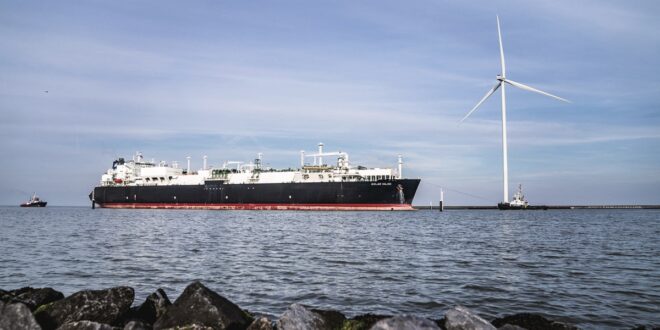Europe and Asia are set to finish the winter without significant disruptions to liquefied natural gas (LNG) supply and without price spikes, despite the ongoing chaos in global commodity shipping due to the Houthi attacks on commercial vessels in the Red Sea.
Weaker demand than historical averages and higher gas stockpiles in both regions have spared them any spikes in spot LNG and benchmark natural gas prices this winter heating season.
While global LNG trade has been upended by the Red Sea disruptions to shipping, supply hasn’t been threatened, and prices in both Europe and Asia have slumped to multi-month lows, even during the peak winter season.
The rest of the winter should be relatively calm for LNG prices and shipping rates, analysts say.
“For all concerned, non-utilisation of the Suez Canal will mean longer journeys over a greater distance. But we think it is unlikely to impact LNG shipping demand and spot rates in the near-term,” Fraser Carson, Senior Research Analyst, Global LNG, at Wood Mackenzie, wrote in an analysis this week.
LNG Shippers Avoid the Red Sea
The Bab el-Mandeb Strait, close to the Red Sea, accounted for 12% of seaborne oil trade and 8% of LNG trade last year, per EIA data.
Two of the biggest LNG exporters, the United States and Qatar, halted shipments via the Red Sea and the Suez Canal earlier this year. Qatar paused LNG cargo journeys through the Suez Canal in the middle of January, but it assured customers and the market that its LNG output is uninterrupted and Europe should expect longer delivery times.
Qatar’s LNG output is in no way threatened by the disruption to shipping in the Red Sea, QatarEnergy’s CEO Saad Sherida Al-Kaabi said earlier this week. Most of Qatar’s LNG cargoes are bound eastward to Asia, while European customers would see longer delivery times, noted the executive, who is also Qatar’s Minister of State for Energy Affairs.
“QatarEnergy confirms that Qatar’s LNG production continues uninterrupted, and our commitment to ensuring the reliable supply of LNG to our customers remains unwavering,” the state firm of Qatar said in January.
“While the ongoing developments in the Red Sea area may impact the scheduling of some deliveries as they take alternative routes, LNG shipments from Qatar are being managed with our valued buyers.”
This week, QatarEnergy’s Al-Kaabi said that the Red Sea chaos is “only going to take longer to get it there. But it will not reach a point where we have to stop production because there isn’t any ship. We’re okay.”
According to WoodMac, Qatar is impacted most by the disruption to shipping, as Qatari LNG deliveries to Europe will effectively take twice as long with vessels traveling to Europe via the Cape of Good Hope (CoGH) in Africa.
“To move all of Qatar’s European DES contracts via the CoGH, we estimate that the equivalent of 18 extra ships would be required,” WoodMac’s Carson said.
“The additional journey time will require some re-scheduling of cargoes and management with its LNG buyers, but its supply to Europe will not be constrained by a lack of shipping.”
Factors Limiting LNG Price Spikes
Flexibility in shipping, where available, will be limiting the fallout from the shipping disruptions, analysts say.
“This could include US LNG which was destined for Asia being rerouted to Europe, and Middle Eastern (Qatari) LNG moving into Asia rather than Europe,” ING commodity strategists Warren Patterson and Ewa Manthey wrote last month.
“In doing this, these flows will avoid the Red Sea and will not have to take the longer route around South Africa.”
Atlantic Basin LNG, especially from the U.S., is also seeing trade shifts, but the end result is more direct voyages, according to Wood Mackenzie.
Before the shipping chaos, the Suez Canal provided the option to deliver cargo into Asia after ships spent several days slow steaming while waiting on their final delivery destination.
“Without that option, ships will spend less time waiting for direction and will deliver straight into Europe or deliver into Southern Asia via CoGH. The slightly longer journey time into South Asia will be offset by the more direct voyages – a result of less trading being taken ‘on the water’”, Wood Mackenzie’s Carson wrote.
Moreover, natural gas inventories in both Europe and Asia are above seasonal norms, even at peak winter, giving the market confidence that gas supply will not be an issue in the northern hemisphere at least until the summer.
Naturally, this has led to lower spot and futures prices in both regions despite the LNG trade flow shifts as a result of the Red Sea crisis.
In Asia, spot LNG prices for April delivery into northeast Asia slumped last week to the lowest in nearly three years—since April 2021, amid higher-than-usual inventories and weak Chinese buying due to the Lunar New Year holiday. Japan’s LNG demand is also lower than in previous years due to restarts of nuclear reactors, high gas inventories, and increased renewable power generation.
Prices in Europe are down to an eight-month low this week amid ample supply and continued weak demand from industry.
All this, “combined with Qatar managing the extra shipping demand from within its fleet, will keep a pin in LNG shipping spot rates into the spring,” WoodMac’s Carson says.

LNG (liquefied natural gas) tanker 'Golar Igloo' arrives in the port of Eemshaven, north of Groningen, on September 4, 2022. (Photo by Siese VEENSTRA / ANP / AFP) / Netherlands OUT
 Iran Energy News Oil, Gas, Petrochemical and Energy Field Specialized Channel
Iran Energy News Oil, Gas, Petrochemical and Energy Field Specialized Channel



